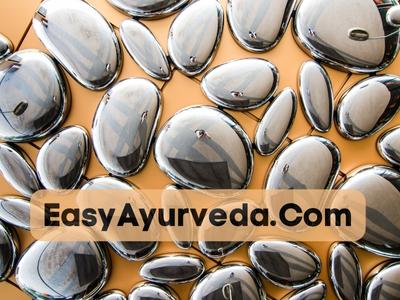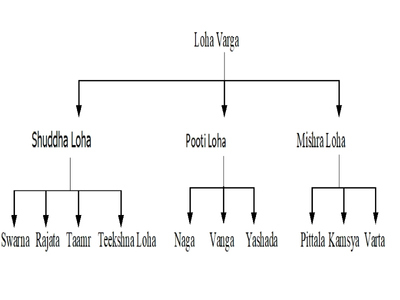Loha Varga (Group of Metals)
At around 8th century A.D., use of metals in minute proportions for treating many diseases became popular in Ayurveda. The branch of Ayurveda dealing with metals and minerals is called Rasashastra. Here iron, copper, gold, silver etc. are used in various diseases.
Table of Contents
Introduction

The root for the word Loha is ‘Luh’, meaning attraction. Lohas are obtained from ores, by heat processing. The synonym of Loha is Dhatu. The substance which, when taken in Bhasma form, helps to get rid of grey hairs, wrinkles, weakness, old age and diseases, the substance which helps to hold the body tissues in proper health for a long period of time (Dharana), such a substance is called as Dhatu. The Dhatus are therapeutically used since thousands of years.
The following are considered as the special features of Metals:
- Every Dhatu has its own aura.
- It is a good conductor of electricity
- Melts on heating
- makes a peculiar sound on beating
- Soluble in particular acids.
- Are available in solids (except Mercury)

Types of Loha
Three types –
- Shuddha Loha – Swarna, Rajata, Tamra, Teekshna Loha.
- Pooti Loha – Naga, Vanga, yashada.
- Mishra Loha – Pittala, Kamsya, Varta.
Suvarna (Gold)
Synonyms – Swarna, kanaka, Hiranya, Suvarna, Kanchana, Hema, Rukma, Kaladhouta, Haataka, Tapaneya, Maangalya, Lohavara.
Gold is a chemical element with the symbol Au (Latin: aurum, “shining dawn”) and an atomic number of 79. Gold is dense, soft, shiny and the most malleable and ductile pure metal known. Some gold salts do have anti-inflammatory properties and are used as pharmaceuticals in the treatment of arthritis and other similar conditions. In modern times, injectable gold has been proven to help to reduce the pain and swelling of rheumatoid arthritis and tuberculosis. Gold is a nobel metal. Aqua regia (Royal Water), a 1:3 mixture of nitric acid and hydrochloric acid, dissolves it.
Types – According to Rasashashtra, Swarna is of five types –
- Prakruta
- Sahaja
- Agnisambhava
- Khanija and Paradavedita.
Prakruta Swarna – Which covers whole of the universe, from which rajas quality is born, that type is called a Prakruta Swarna. It is the rarest.
Sahaja Swarna – The type of Swarna, that caused the origin of Lord Brahma, whose extent is compared to the heights of Meru mountains, that is called as Sahaja Swarna.
Agnisambhava
The vomitus of Agni, after drinking Shivaveerya, it turned into the form of gold. So the name Agnisambhava.
The above three varieties are rare, having divine origin.
Khanija Swarna
This is the one which is got from the ores found in mountains. Its consumption leads to therapeutical benefits.
Qualities – Swarna is Madhura, kashaya rasa, madhura vipaka, Sheeta veerya, Snighdha, light, improves skin colour, rasayana, improves ruchi, agni, bruhmana, aphrodisiac, improves memory, useful in Yakshma, Unmada, Tridosha disorders, Visha and old age.
The 24 carot gold, which is used by rubbing with water, or used in the form of thin layer (Varka) is anti toxic, useful in Yakshma, and Krumi.
Read more about Suvarna here
Rajata (Silver)
Synonyms – Ruchira, Roupya, Tara, Rupyaka, Chandraloha, Chandrahasa, Rupaka, Soudha, Shubhraka, Chandrama.
Silver is a metal with bright shining. It is a good conductor of heat and electricity. It is malleable and ductile. According to mythology silver originated out of left eye tears falling on earth, out of anger from of Lord Shiva.
Silver is a metallic chemical element with the chemical symbol Ag (Latin: argentum, from the Indo-European root *arg- for “white” or “shining”) and atomic number 47. It has the highest electrical conductivity of any element and the highest thermal conductivity of any metal. The metal occurs naturally in its pure, free form (native silver), as an alloy with gold and other metals, and in minerals such as argentite and chlorargyrite. Silver ions and silver compounds show a toxic effect on some bacteria, viruses, algae and fungi, typical for heavy metals like lead or mercury, but without the high toxicity to humans that are normally associated with these other metals. Its germicidal effects kill many microbial organisms in vitro. Silver is widely used in topical gels and impregnated into bandages because of its wide-spectrum antimicrobial activity. The anti-microbial properties of silver stem from the chemical properties of its ionized form, Ag+. This ion forms strong molecular bonds with other substances used by bacteria to respire, such as molecules containing sulfur, nitrogen, and oxygen. When the Ag+ ion forms a complex with these molecules, they are rendered unusable by the bacteria, depriving them of necessary compounds and eventually leading to the bacteria’s death.
Types – Thare are three types
1. Sahaja, 2. Khanjia and 3. Krutrima.
Qualities – Rasa – kashaya Amla, Madhura vipaka, Sheeta veerya, Snigdha, Sarka, Vayasthapana, Balaprada, Ruchikara, Lekhana, Vatapittahara, useful in Bhrama, Unmada etc.
Read more about Rajata here
Tamra (Copper)
Synonyms – Tamra, Suryaloha, Nepaleeya, Tryambaka, Suryanga, Lohitayasa, SHulva, Raviriya, Ratkaka, Bhanuloha.
Copper is a chemical element with the symbol Cu (Latin: cuprum) and atomic number 29. It is a ductile metalwith very high thermal and electrical conductivity. Pure copper is soft and malleable, and a freshly-exposed surface has a pinkish or peachy color. Copper 2+ ions are soluble in water, where they function at low concentration as bacteriostatic substances, fungicides, and wood preservatives. For this reason, copper metal can be used as an anti-germ surface that can add to the anti-bacterial and antimicrobial features of buildings such as hospitals. In sufficient amounts, copper salts can be poisonous to higher organisms as well. However, despite universal toxicity at high concentrations, the 2+ copper ion at lower concentrations is an essential trace nutrient to all higher plant and animal life. In animals, including humans, it is found widely in tissues, with concentration in liver, muscle, and bone. It functions as a co-factor in various enzymes and in copper-based pigments.
Types: There are two types
1. Nepalaka and 2. Mleccha.
Qualities – Tamra has Tikta Kashaya rasa, Madhura Vipaka, UShna Veerya, Saraka, laghu, lekhana, wound healing, good for eyes, does Shodhana in both ways, calms Pitta and Kapha, beneficial in Stomach disorders, Ama, worms, obesity, piles, Kshaya, Anemia, Skin disorders, Shwasa, kasa, Peenasa, Amlapitta, Shotha, Shoola, liver and spleen disorders and Grahani.
Read more about Tamra here
Loha (Iron)
Synonyms – Loha, Ayasa, Shastrala, Teekshnaka, Kaalaayasa, Aayasa.
Iron is a metallic chemical element with the symbol Fe(Latin: ferrum) and atomic number 26. Fresh iron surfaces are lustrous and silvery-grey in color, but oxidize in air to form a red or brown coating of ferric oxide or rust. Iron is essential to nearly all known organisms. In cells, iron is generally stored in the centre of metalloproteins, because “free” iron (which binds non-specifically to many cellular components) can catalyse production of toxic free radicals. Iron deficiency can lead to iron deficiency anemia.
Qualities – Loha is potent rejuvenative. It improves life expectancy, unctuous, calms tridoshas, useful in the treatment of Prameha, Shoola, Gulma, Pleeha, Yakrut, Pandu, Udara diseases, and useful in many diseases with suitable Anupanas.
Read more about Loha here
Mandoora
Synonyms: Loha kitta, Loha mala, Mandoora, Loha sindhanaka, Sindharaka.
In olden days, Mandoora was found in places having mines of Loha and in places for melting of Loha. When Loha was heated, melted, and pounded, the powdery remnants of the Loha, which was discarded, over a period of time, was getting converted into a form of bolus. Mandoora, older than 100 years is of highest quality, 80-year-old Mandoora is of medium quality and 60-year-old Mandoora is of lower quality. Lesser than 60-year-old Mandoora is of bad quality.
Qualities – Vrushya, Sheeta, improves taste, digestion, calms Pittta and increases Rakta. Useful in the treatment of Pandu, Kamala, Shosha, Shotha, haleemaka and Pleeha.
Read nore about Mandoora here
Naga (Lead)
Synonyms – Naga, Bhujanga, Krushnayasi, Seesa, Bhogeshta, Sindukaraka, Seesaka, Kuranga.
Lead (pronounced /ˈlɛd/, led) is a main-group element with symbol Pb (Latin: plumbum) and atomic number 82. Lead is a soft, malleablepoor metal, also considered to be one of the heavy metals. Lead has a bluish-white color when freshly cut, but tarnishes to a dull grayish color when exposed to air. It has a shiny chrome-silver luster when melted into a liquid. Lead has arelative density of 11.3 and melting point of 325 0C.
Qualities – Madhura, Guru, Snigdha, lekhana, Ushna veerya, Sara, Vajeekara, Deepana, Vatarogahara, useful in Raktapradara, Prameha, Arsha etc.
Read more about Naga here
Vanga (Tin)
Synonyms – Vanga, Trapu, Shukraloha, Ranga, Trapusa, Kurupya, Rangaka,a Kutila, Pootigandha.
Tin is a chemical element with the symbol Sn (Latin: Stannum) and atomic number 50. It is a white coloured shining metal. Its relative density is 6.3, melting point – 232 0C. It does not react with atmosphere and is non reactive with acids. Thin sheets of Vanga, when bent forcefully makes a crackling sound. This is called as cry of metal.
Types – 2 types.
1. Khuraka vanga – good quality. 2. Mishraka vanga – Bad quality.
Qualities – Deepana, Paachana, Ruchikaraka, buddhivardhaka, Sheetaveerya, improves beauty, Veerya, heals wounds, useful In Kshaya and noctural emission.
Read more about Vanga here
Yashada (Zinc)
Synonyms: Yashada, Netrarogari, Kharparaja, Tamraranjaka, Reetihetu, Jaastha.
Zinc (pronounced /ˈzɪŋk/ zingk, from German: Zink), also known as spelter, is a metallic chemical element; it has the symbol Zn and atomic number 30. Zinc is included in most single tablet over-the-counter daily vitamin and mineral supplements. t is believed to possess antioxidant properties, which protect against premature aging of the skin and muscles of the body. Zinc also helps speed up the healing process after an injury. ] Zinc gluconate glycine and zinc acetate are used in throat lozenges or tablets to reduce the duration and the severity of cold symptoms.
Its references are found in ancient text books. Ancient scholars are given a place for this metal on par with Loha. Pittala is prepared using this metal. It was known as Kharpara Satwa in ancient times. Yashada is a white coloured metal, brittle, malleable and ductile. It is good conductor of heat and electricity. Its relative density is 7.2 and melting point is 419o C.
Qualities:
Kashaya, Tikta Rasa, Sheeta veerya, good for eyes, kapha, pitta, Prameha, Panduroga and Shwasa.
Mishra Loha:
The alloys, prepared by mixing two or metals is called as Mishra Lohas.
Read more about Yashada here
Pittala (Brass)
Synonyms: Pittala, peetaloha, Kapiloha, Reetika, Aara, Aarakoota.
It is a alloy or mixture of 2 parts of copper and 1 part of Yashada.
Types: Two types. 1. Reetika and 2. Kakatundi.
Qualities – Dry, bitter, salt taste, Ushna veerya, Lekhana, Shodhana, useful in panduroga, blood disorders, Pitta, Kushta.
Read more about Pittala here
Kamsya (Bronze)
Synonyms: Kamseepa, Kamsyaka, Ghoshapushpa, Ghoshaka, Vahniloha, Ghosha.
Copper and Tin are melted together. It is prepared by adding 4 parts of Copper and 1 part of Vanga, in a Musha.
Types: It is of two types.
Pushpa kamsya – white coloured – good
Taila kamsya – red coloured – bad.
Qualities: Tikta, kashaya, Ushna Veerya, Vishada, Khara, improves eye sight, Guru, Rooksha, and calms Kapha and Pitta.
Read more about Kamsya here
Varta Loha
Synonyms: Vartaloha, Marta loha, Panchaloha.
It is a mixture of kamsya, Tamra, Pittala and Naga.
Qualities: kaphapittashamaka, Amla rasa, Kruminashaka, Netraroganashaka, Malashodhaka, deepana and Pachana.









